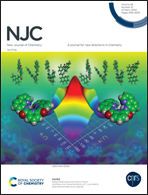A fluorescent DNAzyme-based biosensor for the detection of lead ions using carbon quantum dots prepared from grapefruit peel
Abstract
As a type of heavy metal ion, lead ions can pollute the environment and endanger human health, and thus, research on the detection of lead ions is crucial. In this study, a simple fluorescent biosensor based on lead ion-DNAzyme (Pb-enzyme) cleavage and a hemin/carbon quantum dot complex for the detection of lead ions was fabricated. Magnetic beads were linked to a substrate chain modified by adenosine ribonucleotide (Pb-substrate) via avidin-biotin interaction, Pb-enzyme bound Pb-substrate, and multifunctional magnetic beads were prepared. Carbon quantum dots were prepared from grapefruit peel (G-CQDs) and were characterized using transmission electron microscopy, Fourier-transform infrared spectroscopy, X-ray photoelectron spectroscopy, ultraviolet and visible absorption spectroscopy, and fluorescence spectroscopy analyses. The results indicated that the average particle size of G-CQDs was 2.41 nm, and G-CQDs emitted a bright blue color under ultraviolet irradiation at a wavelength of 350 nm. However, the fluorescence of G-CQDs could be quenched by hemin. When a G-quadruplex was combined with hemin, the fluorescence of hemin/G-CQDs was recovered. In the presence of lead ions, the cleavage activity of the Pb-enzyme was induced, the Pb-substrate strand was cleaved at the modification site, and a single-stranded DNA was released. The single-stranded DNA bound to a hairpin probe, and G-rich sequences of the hairpin probe formed a G-quadruplex, which could restore the fluorescence of hemin/G-CQDs. This fluorescent biosensor exhibits excellent selectivity and sensitivity, with a limit of detection (LOD) value of 5 nM, for lead ions. Moreover, the fluorescent biosensor can be further used to test water samples.



 Please wait while we load your content...
Please wait while we load your content...